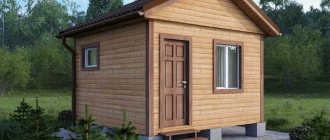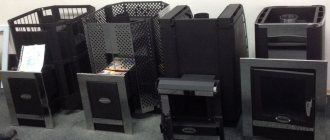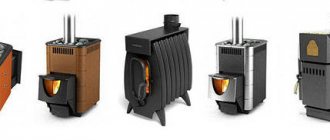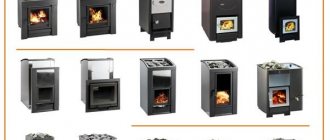Criterias of choice
The main indicators that must be taken into account when choosing a stove are the following:
- mechanism of action;
- manufacturing materials;
- fuel.
Baths can be heated using permanent or temporary (periodic) stoves. The first ones need to be kept burning the entire time the steam room is in use. For the second, preliminary high-quality heating is enough.
The range of materials from which a heater can be made now includes a large number of traditional and new technological elements.
The best stoves are made of steel and brick.
Brick structures
The leaders in demand are heaters made of periodic bricks. Continuous combustion heaters are also used to provide heating for saunas. but much less often.
Brick kilns of intermittent operation have both an advantage - they maintain a high temperature in the room for a long time, and a disadvantage - they need to be warmed up for at least 5 hours. In winter this takes even longer. Therefore, if bathing procedures are planned for the evening, then you need to start heating in the afternoon. After this, you can steam and not be distracted by other things, the heating will work without outside interference.
There is another disadvantage of such models - high cost. It is quite difficult to make such a heater yourself. To get a truly functional stove, you need an experienced stove maker. And his work is highly paid. The high cost of the heating structure can also be explained by the fact that it is necessary to lay a powerful foundation that will support a heavy brick heater.
Metal heat sources
Metal furnaces are characterized by the principle of constant operation. A stove with thin steel walls does not retain heat for long, which can be attributed to its disadvantages. And the advantage of a metal sauna stove is that it will take much less time to warm up the room.
In winter, this will take no more than 2 hours. It is better to organize heating using a steel heater in a small bathhouse. You can install the stove yourself.
Heating by stove-stove
For small baths, a traditional heater remains a viable heating option. In this case, it is enough to purchase or manufacture a heating unit of the required power.
Calculation of equipment power is determined by the formula: 1 kW of power per 1 sq. m of premises. To ensure a comfortable stay for visitors in the steam room, a thermal power reserve of 35 to 55% is additionally taken into account.
The popularity of the heating heater is explained by the following advantages:
- ease of installation and maintenance;
- accessibility of operation;
- using available fuel.
When giving preference to a sauna stove, do not forget about some of the disadvantages of the device:
- impressive dimensions and weight;
- inability to automate the process of heating rooms;
- high fire hazard;
- formation of fuel combustion products.
Modern heaters operate on wood, electricity, liquid and gaseous fuel. The choice of the appropriate option depends on the financial capabilities and technical capabilities of the equipment.
Warm floor system
This option for heating a bathhouse is one of the modern methods, which has been used frequently in recent years. It is quite difficult to install special equipment without the appropriate experience.
It is much easier to install an electric floor system and you can do this work yourself:
- First of all, a waterproofing material is laid, on which a layer of mortar is placed.
- Next comes the installation of thermal insulation.
- An electrical cable is mounted on top of the thermal protection layer and the screed is refilled.
The technology for creating a floor with water heating is similar, but in this case they do not use a cable, but rather lay pipes to circulate the hot coolant.
Rules for organizing heating in a bathhouse
Wood heating sauna
The simplest option is a sauna with heating from home. This scheme involves connecting the steam room, dressing room and other premises to the autonomous heat supply of the cottage. But this can only be realized if the bathhouse structure is closely adjacent to the house or is located at a distance of no more than 3-4 m from it.
The most common option for the location of a building on a site is remote from a residential building. How to make water heating in a bathhouse and at the same time optimize the costs of its organization? Options for using standard schemes are possible, but at the same time the specifics of using the bathhouse should be taken into account:
- The source of thermal energy (boiler) must ensure heating of the air in the steam room to a level of +90°C +100°C. For this purpose, special sauna stoves with a container for stones are used;
- For rooms larger than 60 m², it is recommended to install pipe heating. Together with it, you can make a hot water system to increase comfort. If there is a second floor, heating of the attic of the bathhouse must be provided;
- Ensuring the removal of carbon monoxide along with a well-thought-out ventilation system;
- Fire safety. Since wood is used in the vast majority of cases for finishing rooms, its contact with heating elements - pipes, radiators - should be prevented.
Gas heating baths
Another important point is the choice of energy carrier. Gas heating in a bathhouse is advisable only when installing a specialized boiler. Installing homemade structures can lead to emergency and dangerous situations.
In addition to gas, you can use other, no less effective sources of thermal energy:
- Firewood. A traditional type of fuel with which heating a bathhouse in winter turns into a kind of ritual. A significant drawback is the constant monitoring of the fuel level in the firebox, as well as the impossibility of quickly adjusting the water heating level;
- Diesel fuel or used oil. The most unacceptable energy source for a bathhouse. The problem is the unpleasant smell and the difficulty in organizing fuel storage.
How to make gas heating for a bathhouse yourself? To do this, you need to choose the right equipment and components for heat supply - pipes, radiators, as well as containers for indirect heating of hot water.
When heating a bathhouse from the heating system of the house, part of the pipeline located on the street must be insulated. To solve this problem, you can use special heat insulators or an electric heating wire.
Vodyanoye
Water heating is rightfully considered one of the most convenient and effective methods of heating. In such a situation, there are also several options for manufacturing a system, which in any case will be powered from a furnace with a water circuit.
Fortunately, today in specialized stores you can easily select stoves that are ready for installation, equipped with a heat exchanger. This greatly simplifies the task of any builder of his own bathhouse. And now directly about the options.
Water heated floors
- External heating. It is done very simply and, in fact, is arranged in the same way as a brownie. Pipes located along the walls are connected to the furnace. Depending on the area of your bathhouse, a certain number of heating radiators are connected to the pipes. Hot water passing through them heats the structure and, when cooled, returns back to the boiler.
- Water heated floor. The principle of its operation is the same as in the first option. The only difference is that the pipes are hidden in the floor, which was previously insulated (I wrote about insulating floors in a bathhouse in more detail in other articles). This design is considered non-separable (although, of course, there would be a desire to break everything), and therefore requires a very careful approach to the procedure for its manufacture. In this case, I would recommend contacting
Heating system
In most cases, continuous burning stoves are installed in bathhouses. which do an excellent job as the main source of heat in the room. At the same time, it is worth immediately making a reservation that for arranging the stove it is advisable to use only cleaned stones, the diameter of which reaches 10 centimeters. To achieve the optimal temperature in the room, it takes at least two hours to heat such a stove, during which you will have to periodically add firewood.
The bathhouse is a wooden building with a high level of humidity in the premises. As you know, wood that is regularly exposed to water can become unusable in a very short time. Because of this, unpleasant odors may appear in the bathhouse, and the building itself will require repairs in the future.
To avoid this, issues related to its quality heating should be resolved in advance. At the same time, it is advisable not to limit yourself to just one stove, but to supplement it with various heating systems, which, moreover, will significantly reduce the time it takes to warm up the premises before taking water procedures.
For safety reasons, in a wet room such as a bathhouse, it is allowed to use one or two heating radiators, which must be connected to the heating system of a residential building. In addition, there are several other options for heating a bath, the choice of which depends only on your requirements and wishes.
Heating radiators in the bathhouse
Durability
Durability very much depends on the quality of the material. High-quality cast iron or steel lined with fireclay (without lining there is little hope for a long service life) last for decades with intensive use. Low-quality cast iron can and will last so long, but only if the stove is used as decoration and is heated once or twice a year.
How to understand what “quality” is?
It is very difficult to understand by appearance. Simpler steel, due to its shiny appearance, can evoke more emotions, but will serve much less. It is best to focus on the warranty and the name of the manufacturer. Famous brands will not sacrifice their reputation, but they ask for more money to guarantee quality. Unknown brands and manufacturers with little warranty will charge you less money for the product itself, but you will pay in faster furnace failure in the future.
Drying the bath
There are two components to quickly drying wet rooms: heating and ventilation. They should not be considered separately, because together they work most effectively. You just need to combine them in a specific case.
How to dry: ventilation methods
The ventilation system is laid at the stage of construction of the bathhouse (see here about the diagrams and design of the bathhouse ventilation). Therefore, if something is forgotten, it may be too late to redo everything.
For example, vents are usually made in the foundation - these are through holes lined with sewer (most often) pipes that lead to the underground space. They have plugs on the outside that allow you to open and close them at the right time.
For more details about the scheme, see
Such vents are opened only after procedures. And they serve for better ventilation and drying of the bath.
Also, another through hole is usually made in the wall of the steam room under the shelves, leading to the street. On the inside it has an adjustable plug. This hole is also used to speed up the drying of the steam room.
You can dry the bathhouse in winter with the help of ventilation by opening the windows and doors wide - after all, the air inside is much more saturated with water vapor. But you shouldn’t think that all the moisture will leave the bathhouse only thanks to open doors and windows.
In addition to ways to create a draft simply by opening holes, there is also a method where ventilation actively cooperates with heating and works when the stove is on - this is bastu, which you can read about.
Well, don’t forget that even if natural ventilation is not installed correctly or its power is not enough to ventilate the bathhouse, you can always install fans in the air ducts. Forced ventilation, although noisy, is still effective.
BY THE WAY! Heat guns can help here too.
For those who believe that heating alone is enough, and ventilation becomes optional, we recommend watching the video by Konstantin Bely:
After washing: methods of heating
Heating is just as necessary for drying as ventilation. You understand the mechanism: by heating water molecules, you make them more mobile, transform the water into a gaseous state (steam), and it is easily carried away by the breeze. What will the breeze do if the water is cold? Nothing. And if there is no breeze, the steam will cool over time and calmly settle as condensation.
So, the easiest way to dry a bathhouse after washing in winter is to put one or two logs in the firebox and let them burn out. All ventilation openings must be open.
This is for an iron stove. A brick stove is a heat-storage stove, so its heat is enough to dry the bathhouse after the procedures (together with open ventilation).
***
Well, as you can see, you have to invest some money and make an effort in order to use a large bathhouse in the winter. The smaller it is, the easier it is to warm it up even in cold weather. The power of the sauna stove is calculated for the steam room; it is difficult to fit other things into its responsibilities, because there is summer when all this is not needed. So it is better to use autonomous heaters.
Choice
What are the characteristics of gas stoves intended for baths?
Stones
The traditional stove for a Russian bath - a heater - is distinguished by a large number of round stones placed in a tray. The tray is located above the firebox and, after lighting the stove, heats up quite quickly; the stones heat up to temperatures of 200 degrees or more.
They perform a dual function:
- By accumulating heat, the stones maintain a high temperature in the steam room after the wood burns out.
- The very name “steam room” implies the presence of steam. The traditional mode for a Russian bath is 60 degrees with very high humidity. To add steam, just splash water from a ladle onto the stones.
Gas heater Ermak.
If you are a fan of the Russian bathhouse, a heater is your obvious choice. If you want to use a sauna with high temperatures and minimal humidity, you don't need stones. Heat accumulation in the case of gas, you understand, is of no value.
Water tank location
It may be located in the stove body or around the chimney. In the first case, the heat source for heating water is the burner flame, in the second - combustion products. In the author’s humble opinion, the second option is preferable: the tank additionally cools the combustion products, increasing the efficiency of the device.
Gas stoves
If you use bottled gas, a stove that combines two types of fuel would be an excellent solution for you. When the cylinder runs out, you can light the stove with wood.
Burner
Often it is purchased separately.
What should you pay attention to when purchasing?
- With a steam room volume of 18 m3, the reasonable maximum gas consumption by the burner is 1.5 m3 per hour. It is easy to recalculate the required productivity for your volume.
- The registration certificate and markings must be present. Automatic shutdown when the flame goes out is mandatory (in fact, now it is available almost everywhere).
- Any damage, even seemingly uncritical, puts an end to the device. Big and fat. We are talking about people's lives and health.
Domestic burner Teplofor.
DIY making
Despite the availability of different options for sale, you can try your hand at making a heat exchanger yourself. It's not that difficult if you have welding experience. In any case, it’s easier than making a stove from scratch.
But before you get started, you need to do a little calculation.
Calculation of heat exchanger power and area
It was already mentioned above that heat exchangers connected to the body take away part of the furnace power. Therefore, the first rule will be the following:
IMPORTANT! The heat exchanger power should not be more than 1/10 of the furnace power.
The second rule is related to the length of the pipes: if the system is gravity-fed, then you should not extend the pipes further than three meters. The pump in the system eliminates such restrictions. But the pump is installed more often when the coolant is used to heat rooms. However, if the storage tank is not located too high, you can only wash with a hose. If this is inconvenient, then you need to either take the tank into the attic and insulate it, or install the same pump.
The third rule concerns the volume of the heat exchanger (if it is a small flow-through tank and not a coil). The water in it should heat up within a couple of hours. If it’s longer, then the volume is too big. If it is faster, then it is better only at first glance - the water should not boil, this will cause scale, steam, testing the expansion tank, and other problems.
Now, actually, the calculation itself:
The power of the heat exchanger depends on its area: 9 kW for each square meter of exchanger . The area is quite simple to calculate: if it is a coil, then multiply the circumference (3.14 * diameter) by the length of the pipe. If this is a “samovar” heat exchanger, then take the diameter of the inner pipe, multiply it by the number Pi, and multiply it again by the height of the “samovar”.
Power = resulting area in sq. meters * 9 kW.
If the exchanger hangs on the chimney, you can ignore the rule of deducting its power from the power of the stove. Only if he is on or in her body.
You can calculate the power required to heat a room using the same principle as for a steam room, that is, based on the volume of the room. In the steam room, a kilowatt per cubic meter is taken, but the adjacent ones do not need high temperature, so focus on half the value.
Knowing how many kilowatts are needed to heat a washing room, you get the area of the heat exchanger, and from it the length of the pipe for the “samovar” or coil.
Let's consider a couple of options for self-manufacturing heat exchangers.
Let's assume that you decide to increase the efficiency of the stove by installing a heat exchanger on the chimney.
- The thickness of the steel required for this is 2.5 mm.
- In addition to the sheet material, you will need two pipes with different diameters.
- The smaller one should be adjacent to the chimney pipe, the larger one should be 5-10 cm wider than the first one.
- Two circles are cut out of sheet metal to fit the diameter of the larger pipe, then a hole is cut in the center to fit the diameter of the smaller one and everything is carefully welded.
- You also need to make holes for the pipes through which water will come and go.
- The pipes are threaded and must match the diameter of the connecting pipes.
ADVICE! After checking the tightness of the seams, installation on the chimney and routing of pipes, it is recommended to insulate the heat exchanger using mineral wool and foil - this will dramatically increase the rate of water heating.
Another option for a heat exchanger for a chimney is a coil made of a copper tube with a diameter of 10 mm, which is made to tightly wrap around the chimney pipe. 1.5-2 meters of pipe is enough. The ends of the coil are inserted into the nuts, flared under the fittings, and then the fittings are screwed to the nuts.
Note! The copper tube must be flared exactly under the cone of the fitting so that they eventually fit tightly against each other. Be careful because this is where leaks can occur in the future if you flare at an uneven thickness.
Here are a couple of videos on the topic:
Video
How to bend a copper tube yourself with a pipe bender.
Without pipe bender.
Electrical
And finally, let’s look at several ways to use electricity to heat a bathhouse. I’ll say right away: take care of the electrics in this case. Since the load on thermal electrical appliances is large, the quality of the electrical wiring should not be in doubt. Consider the total load, wire cross-section, wiring diagram and quality of electrical work.
Firstly, your room can be heated using an electric heater. True, in this case you will have to take care of heating the water in the shower in advance (for example, by installing a direct or indirect heating boiler). This type of heater does not require additional arrangement of the chimney and is considered environmentally friendly.
Secondly, the bathhouse (in particular the relaxation room) can be heated using electric convectors placed on the walls.
Well, thirdly, infrared film can come to your aid - the newest type of heater, which allows you to easily and quickly create warm floors both in the house and in the bathhouse. Detailed technology for installing heated floors is discussed in other articles.
Please note that the installation of heated floors is possible without the use of infrared film, but by laying electric heating cables. They are used both in underfloor heating systems and for heating water pipes. It is quite possible to use infrared heaters as an additional source of heat
Hung it on the ceiling and forgot
It is quite possible to use infrared heaters as an additional source of heat. I hung it on the ceiling and forgot about it.
Using electricity to heat a bath undoubtedly has its advantages. You can safely use all the structural elements (heater, heated floor, boiler) at any time all year round. At the same time, you don’t have to worry about fuel or worry about pipes freezing. The only serious drawback can be considered the high energy consumption.
In the case when you do not often use the bathhouse (especially in winter, rarely coming to the dacha), then the most optimal option would be a mixed heating device. For example, a stove is installed and electric heating is installed. If you decide to take a shower, rest or “stretch”, use electricity. If you decide to take a steam bath “like an adult”, turn on the stove thoroughly.
Remember. Whatever the heating in the bathhouse, if you do not use it constantly in winter, then be sure to drain the water from boilers, water heaters, pipes, toilet tank (if there is one), etc. This is guaranteed to protect them from damage, and you from unnecessary headaches.
Heated floor control unit
Designs with built-in heat exchangers
Of all the schemes for retrofitting furnaces with a water heating circuit, this option is considered the most complex. To heat the liquid in a water heater, heat exchangers are used in the form of a twisted spiral or a pipe bent by a frame.
This water circuit device is widely used in industrial sauna stoves. Traditionally, copper pipes with a diameter of 20-25 mm are used to make a heat exchanger in the form of a spiral or snake. Copper alloys conduct heat very well, so the efficiency of the heating system remains always high. The rest room from the stove warms up as quickly as the steam room itself.
For your information! It is impossible to use copper pipes of larger diameter for the water circuit; the water begins to boil, and there is a risk of burning out the copper wall.
If the fluid speed in the system is low, then it is best to use a coil - a snake made of heat-resistant stainless steel.
Since the steam room stove was not initially planned to install a second circuit, there is often simply not enough free space in the combustion chamber. In this case, instead of a coil, heat exchangers in the form of a spatial frame are used.
Brick or metal
The choice of furnace material matters only from the point of view of individual preferences and conditions:
- Price. Based on the cost of the final product, purchasing a metal furnace will be cheaper than purchasing material and paying workers to build a brick furnace. If you do the masonry yourself, the final cost will decrease due to the deduction of payments to hired workers, which will significantly affect the price.
- Bath area. Metal stoves take up less space, so if the area is small, the choice is definitely in favor of a metal product.
- Difficult to install. A brick stove requires a separate foundation, which lengthens the installation period; a metal stove is installed on a lighter base. The wood-burning sauna stove is quite popular and is practical.
- Sometimes the decisive factor is a photo of a factory-made metal stove - the range of modern manufacturers is distinguished by functionality and attractive design.










